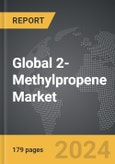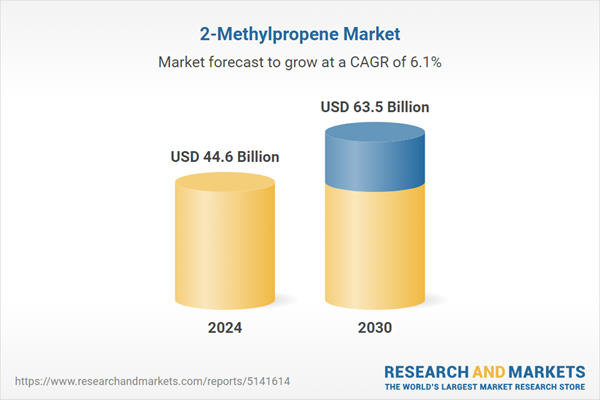Global 2-Methylpropene Market - Key Trends & Drivers Summarized
Why Is 2-Methylpropene Critical for the Chemicals and Plastics Industries?
2-Methylpropene, also known as isobutylene, is a highly valuable hydrocarbon used as a feedstock in the production of several key chemicals and polymers. It is integral to the production of polyisobutylene (PIB), butyl rubber, and methyl tert-butyl ether (MTBE), all of which are critical materials in industries such as automotive, construction, and fuel production. Butyl rubber, in particular, is prized for its excellent impermeability, making it ideal for manufacturing tires, medical stoppers, and sealants. The growing demand for fuel additives and synthetic rubber products is propelling the need for 2-Methylpropene in global markets. Furthermore, its use in lubricants, adhesives, and coatings highlights its versatility across various industrial applications.How Are Environmental Regulations Impacting the 2-Methylpropene Market?
The 2-Methylpropene market is being shaped by evolving environmental regulations, particularly in fuel production and emissions reduction. The use of 2-Methylpropene to manufacture MTBE, a fuel additive that improves the octane rating of gasoline, has been subject to scrutiny due to environmental concerns, particularly in the United States where its use has been restricted. However, in many other regions, such as Asia and the Middle East, MTBE remains a key component in fuel production. As the global energy sector shifts toward cleaner alternatives, there is also increasing interest in bio-based isobutylene, derived from renewable feedstocks, which presents a more sustainable option. These trends highlight the industry's transition toward greener alternatives and compliance with stricter environmental regulations.How Is 2-Methylpropene Used in the Automotive Industry?
2-Methylpropene plays a pivotal role in the automotive industry, particularly through its use in butyl rubber and polyisobutylene. Butyl rubber, a product of isobutylene polymerization, is the material of choice for inner tire linings, thanks to its excellent air retention properties. As the global automotive industry grows, particularly in emerging markets, the demand for butyl rubber continues to rise. Additionally, polyisobutylene (PIB) is used as an additive in lubricants, improving viscosity and reducing engine wear. With the increasing focus on fuel efficiency and vehicle performance, PIB's role in high-performance lubricants is gaining prominence, contributing to the expanding use of 2-Methylpropene in automotive applications.What Is Driving Growth in the 2-Methylpropene Market?
The growth in the 2-Methylpropene market is driven by several factors, including the rising demand for butyl rubber in the automotive industry, increased use of polyisobutylene in high-performance lubricants, and the growing need for fuel additives in global markets. As automotive production expands globally, particularly in Asia-Pacific, the need for 2-Methylpropene-derived materials is accelerating. The shift towards bio-based alternatives and environmentally friendly production methods is also influencing the market, as companies explore sustainable options to reduce carbon footprints. Additionally, the continued use of MTBE in fuel production across several regions ensures steady demand for 2-Methylpropene in the petrochemical sector, further driving market growth.Report Scope
The report analyzes the 2-Methylpropene market, presented in terms of market value (US$ Thousand). The analysis covers the key segments and geographic regions outlined below.- Segments: Application (Rubber Manufacturing, Pharmaceuticals, Fuel & Lubricant, Adhesives & Sealants, Antioxidants, Other Applications); Product (Butyl Rubber, Poly isobutylene, MMA Monomer, Isooctane, MTBE, Other Products).
- Geographic Regions/Countries:World; United States; Canada; Japan; China; Europe (France; Germany; Italy; United Kingdom; Spain; Russia; and Rest of Europe); Asia-Pacific (Australia; India; South Korea; and Rest of Asia-Pacific); Latin America (Argentina; Brazil; Mexico; and Rest of Latin America); Middle East (Iran; Israel; Saudi Arabia; United Arab Emirates; and Rest of Middle East); and Africa.
Key Insights:
- Market Growth: Understand the significant growth trajectory of the Butyl Rubber segment, which is expected to reach US$4.7 Billion by 2030 with a CAGR of a 6.6%. The Poly isobutylene segment is also set to grow at 6.2% CAGR over the analysis period.
- Regional Analysis: Gain insights into the U.S. market, valued at $11.6 Billion in 2024, and China, forecasted to grow at an impressive 9.4% CAGR to reach $15.1 Billion by 2030. Discover growth trends in other key regions, including Japan, Canada, Germany, and the Asia-Pacific.
Why You Should Buy This Report:
- Detailed Market Analysis: Access a thorough analysis of the Global 2-Methylpropene Market, covering all major geographic regions and market segments.
- Competitive Insights: Get an overview of the competitive landscape, including the market presence of major players across different geographies.
- Future Trends and Drivers: Understand the key trends and drivers shaping the future of the Global 2-Methylpropene Market.
- Actionable Insights: Benefit from actionable insights that can help you identify new revenue opportunities and make strategic business decisions.
Key Questions Answered:
- How is the Global 2-Methylpropene Market expected to evolve by 2030?
- What are the main drivers and restraints affecting the market?
- Which market segments will grow the most over the forecast period?
- How will market shares for different regions and segments change by 2030?
- Who are the leading players in the market, and what are their prospects?
Report Features:
- Comprehensive Market Data: Independent analysis of annual sales and market forecasts in US$ Million from 2024 to 2030.
- In-Depth Regional Analysis: Detailed insights into key markets, including the U.S., China, Japan, Canada, Europe, Asia-Pacific, Latin America, Middle East, and Africa.
- Company Profiles: Coverage of players such as BASF SE, Chevron Phillips Chemical Company, Evonik Industries AG, Heilongjiang Anruijia Petrochemical Co., Ltd., LyondellBasel Industries NV and more.
- Complimentary Updates: Receive free report updates for one year to keep you informed of the latest market developments.
Some of the 12 companies featured in this 2-Methylpropene market report include:
- BASF SE
- Chevron Phillips Chemical Company
- Evonik Industries AG
- Heilongjiang Anruijia Petrochemical Co., Ltd.
- LyondellBasel Industries NV
- Shandong Yuhuang Chemical (Group) Co., Ltd.
- Songwon Industrial Co., Ltd.
- Sumitomo Chemical
- TPC Group
- Zibo Qixiang Petrochemical Group Ltd.
This edition integrates the latest global trade and economic shifts into comprehensive market analysis. Key updates include:
- Tariff and Trade Impact: Insights into global tariff negotiations across 180+ countries, with analysis of supply chain turbulence, sourcing disruptions, and geographic realignment. Special focus on 2025 as a pivotal year for trade tensions, including updated perspectives on the Trump-era tariffs.
- Adjusted Forecasts and Analytics: Revised global and regional market forecasts through 2030, incorporating tariff effects, economic uncertainty, and structural changes in globalization. Includes historical analysis from 2015 to 2023.
- Strategic Market Dynamics: Evaluation of revised market prospects, regional outlooks, and key economic indicators such as population and urbanization trends.
- Innovation & Technology Trends: Latest developments in product and process innovation, emerging technologies, and key industry drivers shaping the competitive landscape.
- Competitive Intelligence: Updated global market share estimates for 2025, competitive positioning of major players (Strong/Active/Niche/Trivial), and refined focus on leading global brands and core players.
- Expert Insight & Commentary: Strategic analysis from economists, trade experts, and domain specialists to contextualize market shifts and identify emerging opportunities.
Table of Contents
Companies Mentioned (Partial List)
A selection of companies mentioned in this report includes, but is not limited to:
- BASF SE
- Chevron Phillips Chemical Company
- Evonik Industries AG
- Heilongjiang Anruijia Petrochemical Co., Ltd.
- LyondellBasel Industries NV
- Shandong Yuhuang Chemical (Group) Co., Ltd.
- Songwon Industrial Co., Ltd.
- Sumitomo Chemical
- TPC Group
- Zibo Qixiang Petrochemical Group Ltd.
Table Information
| Report Attribute | Details |
|---|---|
| No. of Pages | 179 |
| Published | December 2025 |
| Forecast Period | 2024 - 2030 |
| Estimated Market Value ( USD | $ 44.6 Billion |
| Forecasted Market Value ( USD | $ 63.5 Billion |
| Compound Annual Growth Rate | 6.1% |
| Regions Covered | Global |









